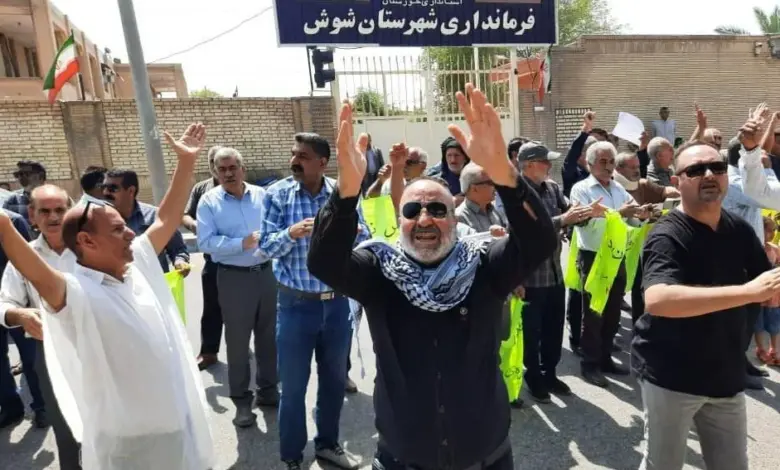Iran Protests in 2023: A Year of Persistent Discontent

iran protests 07052023
Written by
Mehdi Oghbai
In 2023, Iran experienced a tumultuous year marked by persistent public protests against the regime. The flames of dissent ignited in the previous year’s nationwide uprising and continued to flicker throughout the year, with various segments of the population expressing their grievances through gatherings, marches, and strikes.
Retirees, totaling 1,362 accounts, emerged as a significant force, staging protests across cities against unfair wages, unpaid salaries, and deteriorating living conditions. Depletion of Social Security and Pension Funds by successive governments fueled their demands for justice.
On 592 occasions, Iranian workers took to the streets, protesting job dismissals, lack of employment status changes, job insecurity, non-payment of wages and benefits, unequal wages, and harsh working conditions. A notable event occurred at the Ahvaz factory of Iran National Steel Industrial Group (INSIG), where thousands of workers protested the termination of 21 colleagues. The protest lasted eight days, resulting in the reinstatement of the dismissed workers and concessions from the factory’s management.
In 2023, 141 protests by teachers and educators unfolded across the country. Their concerns ranged from the poisoning of female students to school privatization plans and objections to the employment of inexperienced teachers.
Students were a vocal presence, taking to the streets on 56 occasions to protest the poisoning of female students, executions in Isfahan, security pressures, dormitory conditions, food status, as well as the purge of students and professors. High school students also protested on three occasions, highlighting the widespread discontent among the youth.
The healthcare sector was not exempt from protests, with nurses staging 95 protests and doctors organizing 11 protests against job dismissals, tariff arrangements, non-receipt of nursing fees, poor living conditions, strenuous working conditions, mandatory overtime, and other grievances.
Market vendors staged 133 protests, addressing grievances such as exorbitant taxes, new tax laws, increased rent, rising dollar prices, exchange rate instability, shop closures, power cuts, and proposals for closing businesses.
March 14 – Tehran, #Iran
Large crowd of locals in the city's Afsariyeh district are seen chanting: "No fear! We're all together!"#IranRevolution pic.twitter.com/EUJaAuqvFA— People's Mojahedin Organization of Iran (PMOI/MEK) (@Mojahedineng) March 14, 2023
Protests extended beyond specific professions, with farmers, truck drivers, architects, engineers, bakers, lawyers, taxpayers, and various segments of Iran’s society collectively reporting 690 protests in 2023. Their focus was on economic hardships, government looting, poverty, and general economic difficulties.
Despite facing a formidable security apparatus and systemic disregard by state officials, Iranians demonstrated remarkable organization and perseverance. Street demonstrations were coordinated through social media, enabling citizens to gather simultaneously in dozens of cities at the same time and for a common purpose.
The 2022 nationwide uprising, triggered by the death of 22-year-old Mahsa Amini at the hands of the morality police, also served as a catalyst for the protests throughout 2023. A total of 524 protests directly linked to the uprising took place, demonstrating the enduring impact of the movement.
The protests also highlighted the growing public awareness of environmental issues. A significant three-day protest in Ardakan, where thousands of locals took to the streets to express their anger over environmental damage, underscored the importance of environmental protection and the people’s determination to safeguard their environment.
The strikes by oil and gas industry workers and steelworkers in Isfahan and Ahvaz sent a stark message to the regime that their exploitation of the working class would not go unchallenged. These strikes demonstrated the power of organized labor and the potential for wider economic disruptions if the regime continues to ignore the needs of the working class.
Noteworthy protests included ongoing Friday rallies in Zahedan, continuing for months despite a crackdown from armed security forces deploying torture and arbitrary arrests.
#Iran News in Brief
Amid state efforts to crack down on weekly protests in Sistan and Baluchestan province, the commander of the province’s State Security Forces announced the deployment of armored vehicles to "enhance security."https://t.co/itwPKqNkQo pic.twitter.com/MF6q4t0NFH— NCRI-FAC (@iran_policy) November 16, 2023
In conclusion, 2023 witnessed a total of 3,617 protests, reflecting the persistent discontent among various segments of the population. Economic grievances, concerns over living conditions, and responses to perceived injustices and government policies characterized these protests. The continuation of these demonstrations signals an ongoing challenge to the authorities and underscores the resilience of the people’s spirit in the face of adversity.
These protests stand out not just for their duration or widespread reach, but for the deep political undercurrents in each grievance held by the Iranian people. Since the 1980s, whenever Iranians have bravely challenged their oppressors, it hasn’t just sparked local dissent – it has set off a nationwide movement. What began as economic frustrations have evolved into powerful chants like “Death to Khamenei.”
Over time, these movements have sped up, and Iranians, more radicalized, express their dissatisfaction more passionately. Now, the ruling establishment faces a crucial choice: either shift focus from terrorism and regional pursuits to address the growing political, social, and economic discontent, or persist in suppressing dissent with a weakening security apparatus, all while globally isolated and under sanctions.

